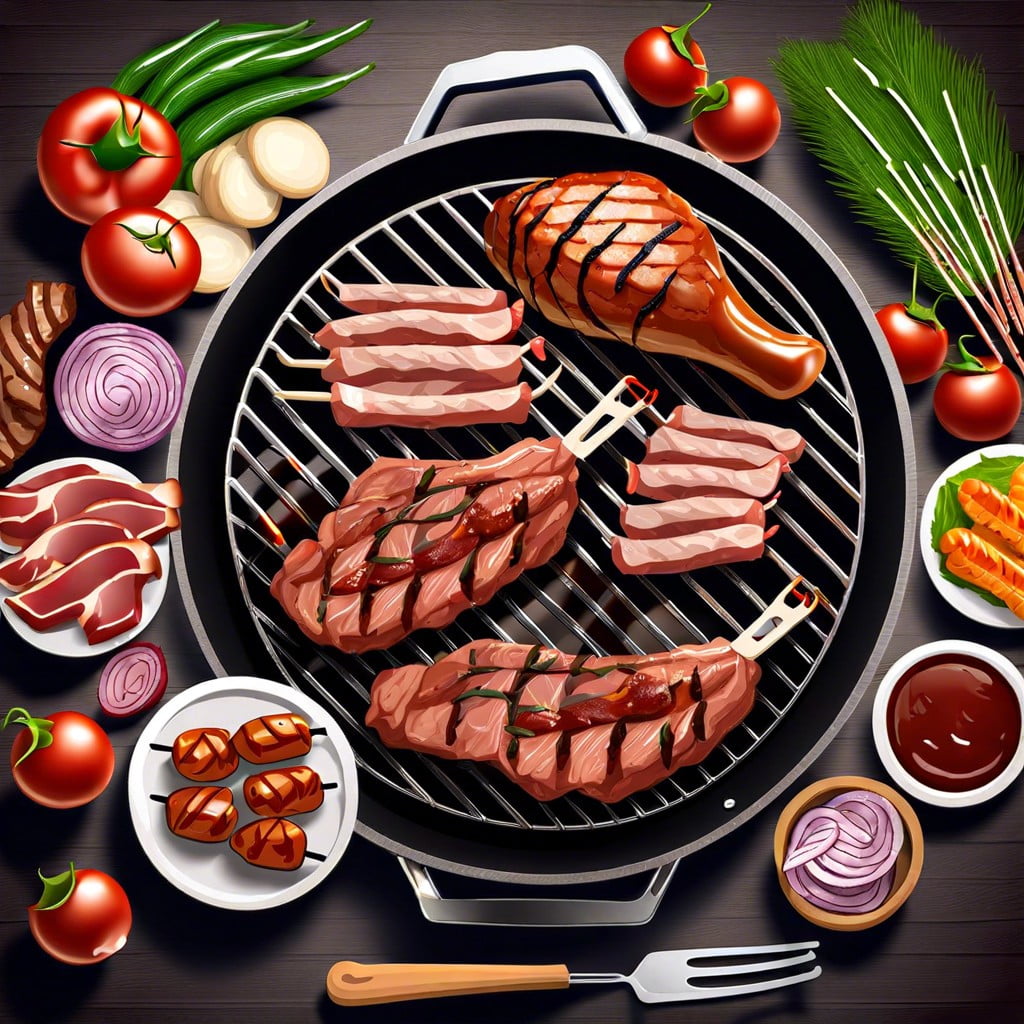This article provides clear guidelines on how much BBQ to prepare for each guest, ensuring no one leaves the table hungry.
Key takeaways:
- Serve 1/2 to 3/4 pound of meat per adult, 1/4 to 1/2 pound per child.
- Adjust portions based on specific type of meats being served.
- Consider guest demographics and adjust accordingly.
- Variety of meats allows for smaller portions per person.
- Estimate accurately to avoid excessive leftovers.
Calculating BBQ Meat Per Person

To ensure each guest at your BBQ leaves satisfied, aim to serve approximately 1/2 to 3/4 pound of meat per adult and 1/4 to 1/2 pound per child. These figures should adjust based on the specific type of meats being served.
For example:
- Ribs: Typically richer and more filling, so account for roughly 4-5 ribs per person.
- Brisket: Owing to its hearty nature, estimate about 1/2 pound per person when sliced.
- Chicken: One-quarter of a chicken or two pieces (breast and wing or thigh and drumstick) per person is standard.
- Burgers: One burger per person, with an extra patty for those with larger appetites.
Remember, these are starting points. Adjust for the expected eating habits of your guests and the duration of your event. An all-day affair may require more food than a quick evening get-together.
Considerations for Determining Meat Quantities
When planning a BBQ, assess the guest list to gauge meat quantities effectively. Adults typically consume more than children, so allocate about 1/2 pound of meat per adult and 1/4 pound per child as a starting point. Adjust these amounts for heavy meats like ribs, where a rack serves two to three people.
For mixed gatherings, consider that men usually eat more than women, aiming for 2/3 to 3/4 pound of meat per man and 1/2 pound per woman. Additionally, the presence of side dishes can reduce the quantity of meat needed, as guests will likely fill their plates with a balance of options.
Factor in the type of event; a sports gathering may call for heartier portions compared to a casual backyard get-together. Remember, these are starting guidelines. Adjust accordingly based on the specific group you’re serving.
Factors Affecting Meat Consumption At a BBQ
When planning your BBQ, be mindful of your guest list. Meat consumption can vary widely based on the demographics of your attendees. Adults typically eat more than children, with a standard serving being about 6 ounces of cooked meat per adult, and slightly less for children.
Males often consume more than females, so adjust your calculations if you have a predominantly male guest list. The time of day also plays a role. An evening BBQ usually features meat as the main attraction, whereas at a lunch event, guests may eat less.
Additionally, consider the variety of meats on offer. If you’re serving multiple types of meat, you can reduce the serving size per person for each type since guests will likely want to try a bit of everything. Keep in mind the nature of the event too – a casual backyard gathering may have more relaxed eating, while at a more formal event, guests might consume less.
Lastly, account for the side dishes. A generous spread of sides can mean less meat per person, as they fill up on the accompanying offerings. Ensure a balance in your BBQ menu to allow for a satisfying meal without excessive leftovers.
Addressing Leftovers: Strategies for Estimating Accurately
When planning a BBQ, the fear of running out of food often leads to overestimation, resulting in excess leftovers. To estimate more accurately:
- Gauge your guests’ appetite: Factor in age, gender, and activity level. Adults generally consume more than children, and a physically active crowd might have a larger appetite.
- Diversity on the plate matters: If you’re serving a variety of mains and sides, guests are likely to take smaller portions of each.
- Know your meats: Fattier cuts like brisket yield less after cooking, so factor in shrinkage. For bone-in meats, account for the weight of the bone.
- Sides and apps count: Abundant side dishes and appetizers can reduce the amount of meat consumed.
- Consider the event length: For longer gatherings, people may eat more.
- Apply the 1.5 Rule: Aim for about 1.5 times the amount of food you’d normally serve if you want a comfortable cushion without excessive leftovers.
- Learn from the past: If you’ve hosted BBQs before, adjust based on what ran out and what was left over.
By addressing these points, you’ll strike a balance, ensuring everyone is satisfied with minimal waste.
Practical Tips for BBQ Meal Planning
To ensure a successful BBQ with just the right amount of food, keep these pointers in mind:
- Start with a headcount: Secure RSVPs to gauge the number of guests.
- Account for appetites: Children typically eat less, while teenagers and adults, particularly those with larger appetites, may consume more.
- Balance the menu: Complement meats with sides. Dense sides like potatoes could mean less meat is needed.
- Offer variety: Mix heavy proteins with lighter options, such as chicken or fish, and vegetarians will appreciate a meat-free alternative.
- Plan for extras: For a mixed crowd, anticipate that about a third will have second helpings.
- Remember the extras: Don’t forget to count condiments, buns, and other additions in your planning.
By sticking to these guidelines, you can anticipate your guests’ needs without the worry of excess or shortage.

